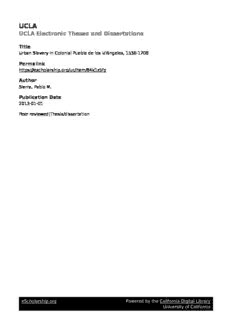
UNIVERSITY OF CALIFORNIA Los Angeles Urban Slavery in Colonial Puebla de los Ángeles ... PDF
Preview UNIVERSITY OF CALIFORNIA Los Angeles Urban Slavery in Colonial Puebla de los Ángeles ...
UCLA UCLA Electronic Theses and Dissertations Title Urban Slavery in Colonial Puebla de los �ngeles, 1536-1708 Permalink https://escholarship.org/uc/item/84k1z5fp Author Sierra, Pablo M. Publication Date 2013 Peer reviewed|Thesis/dissertation eScholarship.org Powered by the California Digital Library University of California UNIVERSITY OF CALIFORNIA Los Angeles Urban Slavery in Colonial Puebla de los Ángeles, 1536-1708 A dissertation submitted in partial satisfaction of the requirements for the degree Doctor of Philosophy in History by Pablo M. Sierra 2013 © Copyright by Pablo M. Sierra 2013 ABSTRACT OF THE DISSERTATION Urban Slavery in Colonial Puebla de los Ángeles, 1536-1708 by Pablo M. Sierra Doctor of Philosophy in History University of California, Los Angeles, 2013 Professor Kevin B. Terraciano, Chair This study addresses the emergence, rapid development and gradual decline of chattel slavery in the city of Puebla de los Ángeles during the early and mid-colonial period. The presence and exploitation of African slaves in Puebla has been ignored in the historiography of colonial Mexico (New Spain), Latin America, and the greater African Diaspora. By crossreferencing extant municipal, notarial, parochial and judicial records with Spanish- and Nahuatl-language colonial chronicles, I reconstruct the history of African slaves and their descendants in Puebla from 1536 to 1708. My notarial investigation focuses on bills of slave purchase, letters of manumission, apprentice contracts and loans produced between 1600 and 1700. I find that during the seventeenth century, 20,000 slaves were bought in notarized transactions in the Puebla slave market. The city's large and wealthy Spanish population demanded large retinues of skilled and unskilled slaves to labor as domestics, water carriers, wet nurses, textile workers, etc. The owners of sugar plantations (ingenios) in nearby Izúcar, Cuautla, and the Cuernavaca basin also required large numbers of enslaved workers in the context of extreme Indigenous depopulation. ii By the 1620s, a series of epidemics, combined with exploitative labor practices, reduced the Indigenous population of Central Mexico and the greater Puebla-Tlaxcala Valley to 10% of its pre-Hispanic levels. In response, the Spanish Crown authorized the implementation of a sophisticated slave trading system, led by Angola-based Portuguese merchants, to operate in Puebla de los Ángeles. These Lusophone networks relied on the encomendero de negros, a locally-based merchant to regulate the entry and sale of all new African arrivals to the city between 1616 and 1639. Yet African slaves had already begun to erode the foundations of chattel slavery well before these dates. Although theoretically reduced to human property under Spanish law, Afro-Poblano slaves actively resisted their bondage by exercising their religious rights as practicing Catholics. In particular, male slaves established numerous formal unions with free women (of all races) through the sacrament of matrimony. In turn, children born of these unions were legally free, leading to numerous generations of free Afro-Poblanos by the end of the seventeenth century. iii The dissertation of Pablo M. Sierra is approved. Lauren Derby Mark Q. Sawyer William R. Summerhill Kevin B. Terraciano, Committee Chair University of California, Los Angeles 2013 iv To Marina Sánchez Gómez, mi abuela. v TABLE OF CONTENTS List of Tables vii List of Acronyms viii Acknowledgments ix Vita xii Introduction 1 Chapter 1 - Formative Slavery in the Puebla-Tlaxcala Valley, 1536-1580 21 Chapter 2 - The Transatlantic Voyage: From Angola to Cuextlaxcoapan, 1595-1635 52 Chapter 3 - The African Influx and the Puebla Slave Market, 1600-1700 81 Chapter 4 - Failed Freedoms, Manumissions and Apprenticeships 122 Chapter 5 - Slave Matrimony and Afro-Indigenous Interactions 158 Conclusion - A City of Freedmen 200 Bibliography 219 vi LIST OF TABLES Table 2.1. Slave trains conducted from Veracruz to Puebla de los Ángeles 63 Table 3.1. Male-female slave ratios in the Puebla slave market, 1600-1639 90 Table 3.2. Average purchase price for slaves in Puebla by age group, 1600-1635 92 Table 3.3. African slaves sold in Puebla by ethnic labels/origin, 1595-1635 107 Table 5.1. Number of married slaves owned by obrajeros in 17th-century Puebla 171 Table 5.2. Groom marital preference by ethnic/cultural labels, 1585-1615 177 Table 5.3. Slave-free marriages in Sagrario and San José by legal status, 1585-1657 183 Table 5.4. Number of grooms and brides by race and legal status, 1660-1700 186 vii LIST OF ACRONYMS AGN Archivo General de la Nación (México) AGNP Archivo General de Notarías del Estado de Puebla AHJP Archivo Histórico Judicial de Puebla AHPA Archivo Histórico de la Parroquia del Santo Angel Custodio de Analco AMP Archivo Municipal de Puebla APSJ Archivo Parroquial del Señor San José, Puebla ASMP Archivo del Sagrario Metropolitano de Puebla viii
Description: